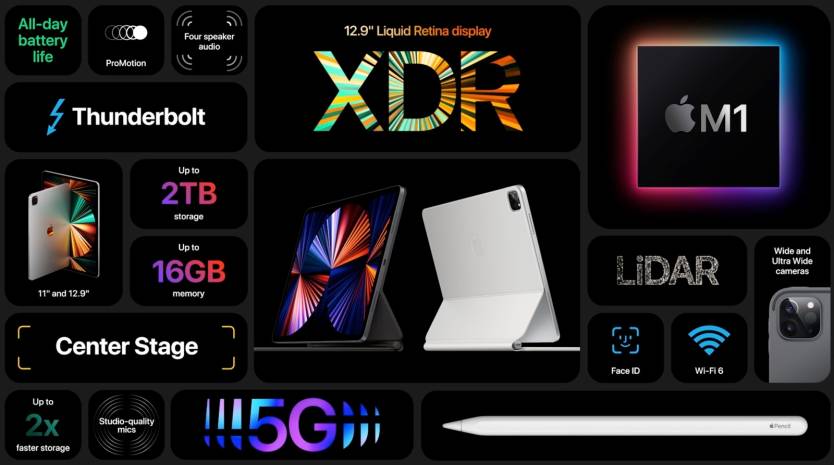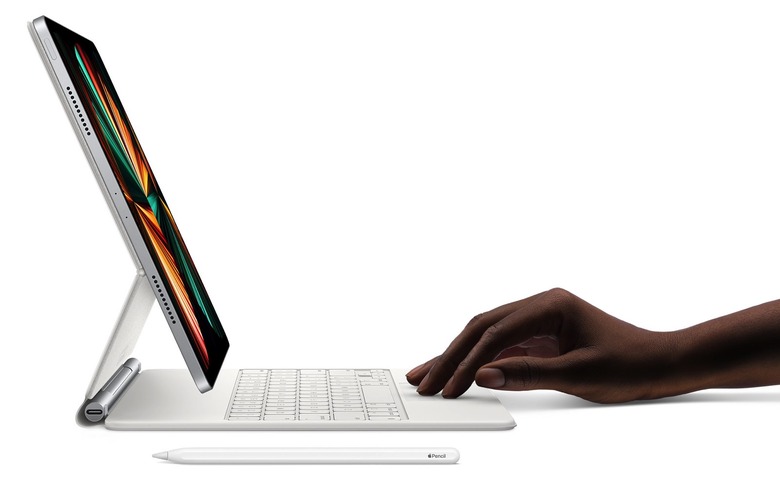New iPad Pro Has A Secret Feature That Apple Can't Really Talk About
Starting at $799 or $1,099, depending on the model, the 2021 iPad Pro is Apple's first tablet that shares the same powerful processor with four MacBooks. The Apple M1 System-on-Chip (SoC) that Apple introduced in November has been widely praised, inducing a terrifying nightmare over at Intel — the chipmaker has been attacking Apple's M1 laptops in ad campaigns for a few months. The M1 is faster than anything Apple made so far and more energy-efficient than competing chips that you'd see in laptops. It's so good that Apple decided to use the M1 in both the new iPad Pro and iMac, products that were unveiled only last Tuesday.
This prompted speculation again that the iPad and Mac are on converging paths. Fans are again wondering when the iPad will run macOS, now that it shares the same hardware as Macs. Not only that, but macOS looks and feels a lot like iOS after the Big Sur update. In a new round of interviews, Apple insisted that it has no plans to unify the two different platforms. The iPad and Mac have different purposes, and Apple will continue to make the best possible tablet and computer experiences it can. But these interviews might have revealed the iPad Pro's secret feature that Apple can't even talk about yet.
Apple's Greg Joswiak, senior vice president of worldwide marketing, and John Ternus, senior vice president of hardware engineering, delivered the same iPad Pro talking points to the press in various interviews. The two fielded questions about the similarities and differences between the M1 iPad Pro and M1 Macs, telling interviewers that Apple has no plans to merge the two products.
Joswiak provided a familiar answer to TechCrunch when asked how they would characterize an iPad Pro vs. a MacBook buyer.
"This is my favorite question because you know, you have one camp of people who believe that the iPad and the Mac are at war with one another, right it's one or the other to the death. And then you have others who are like, no, they're bringing them together — they're forcing them into one single platform, and there's a grand conspiracy here," the exec said. He made the same point in a previous interview.
"They are at opposite ends of a thought spectrum, and the reality is that neither is correct," Joswiak continued, adding that Apple works hard to make the best possible products in their respective categories.

iPad Pro (2021) specs and features announced at Apple's "Spring Loaded" event.
These interviews also highlighted a different M1 iPad Pro talking point, headroom. People comparing the M1 iPad Pro to the M1 MacBooks might rightly observe that the new tablets have various hardware advantages over Macs and a significant disadvantage. The iPad Pro packs Face ID and a much better FaceTime camera experience, optional 5G connectivity, a touchscreen with Apple Pencil support, and a mini-LED display on the 12.9-inch model. But M1 Macs have macOS, a more versatile operating system that does a better job at multitasking than iOS can. The iPad Pro might not even be able to make the most of that M1 performance.
Joswiak addressed the massive power that comes with the M1, explaining that the iPad Pro's specs are meant to offer headroom to users and developers.
"One of the things that iPad Pro has done as John [Ternus] has talked about is push the envelope. And by pushing the envelope that has created this space for developers to come in and fill it. When we created the very first iPad Pro, there was no Photoshop," Joswiak said. "There was no creative apps that could immediately use it. But now there's so many you can't count. Because we created that capability, we created that performance — and, by the way, sold a fairly massive number of them — which is a pretty good combination for developers to then come in and say, I can take advantage of that. There's enough customers here, and there's enough performance. I know how to use that. And that's the same thing we do with each generation. We create more headroom to performance that developers will figure out how to use."
"The customer is in a great spot because they know they're buying something that's got some headroom, and developers love it."
Joswiak insisted on the same headroom in response to The Independent a few days ago. The site made a point to observe that Apple is also one of those developers that might be planning to take advantage of the extra headroom. The exec joked that he's not going to let something like that slip out.
Given that iPad Pro headroom is a clear talking point in Apple's iPad Pro marketing, it seems the tablet has a "secret" feature that Apple can't talk about. That's iPadOS 15, which will be unveiled in a few weeks at WWDC 2020.
Some of the iOS 15 and iPadOS 15 features have leaked recently, with a report saying that widgets are coming to the tablet in a major home screen redesign. The leak did not go into more detail about Apple's planned software updates for the iPad Pro. It's unclear whether Apple will modify the multitasking experience on iPadOS to take advantage of the M1's power. Any changes to iPadOS should also apply to older tablets, as well as mid-range iPads. Those feature previous-gen A-series chips.
I am now 100% confident that FCPX, Logic Pro & Xcode are coming to iPad Pro.
I cannot confidently say to what capacity, or with what limitations due to RAM management — but it's happening within the next year or so.
You can choose to trust me on that, or not, I suppose 🤷🏼♂️😂
— jon prosser (@jon_prosser) April 22, 2020
But there are other ways for Apple to take advantage of that M1 that doesn't involve changing the iPadOS experience on the other iPads. Rumors said earlier this year that Apple is looking to bring various apps that professionals use on Macs to iPad. The list includes Final Cut Pro X, Logic Pro, and Xcode. Given Apple's insistence on headroom when promoting the new iPad Pro, those rumors seem even more exciting right now.
